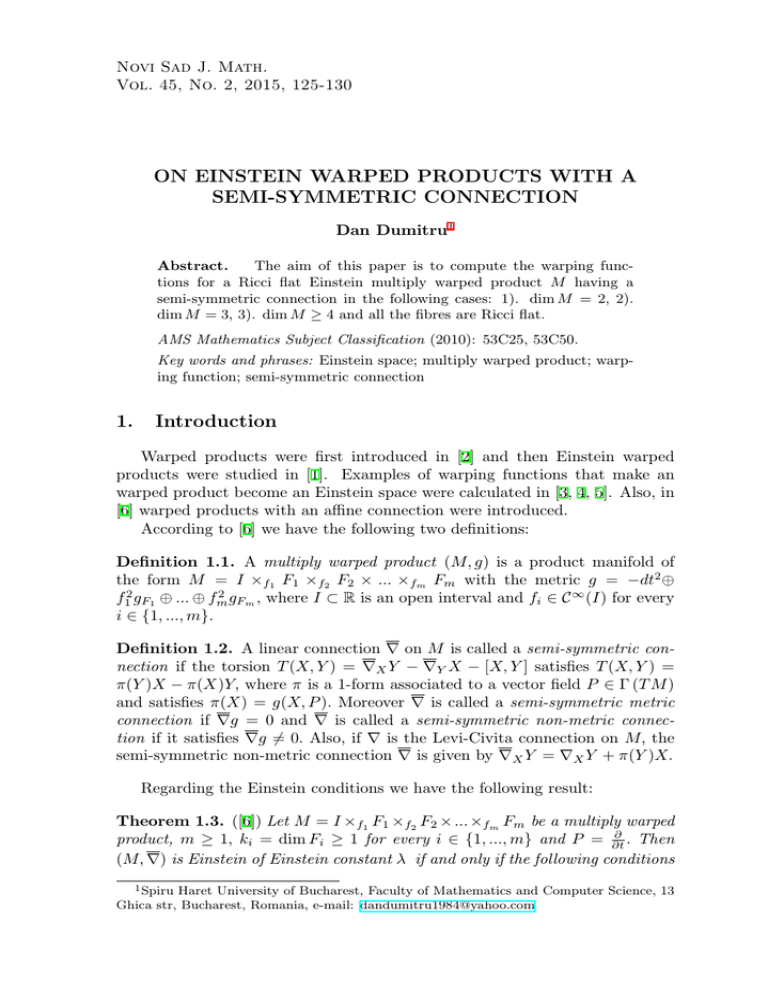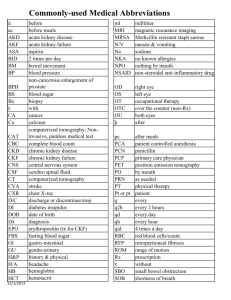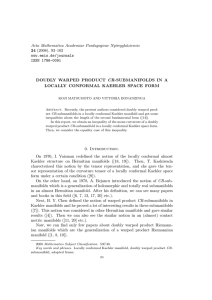ON EINSTEIN WARPED PRODUCTS WITH A SEMI-SYMMETRIC CONNECTION 1. Introduction
advertisement

Novi Sad J. Math.
Vol. 45, No. 2, 2015, 125-130
ON EINSTEIN WARPED PRODUCTS WITH A
SEMI-SYMMETRIC CONNECTION
Dan Dumitru1
Abstract.
The aim of this paper is to compute the warping functions for a Ricci flat Einstein multiply warped product M having a
semi-symmetric connection in the following cases: 1). dim M = 2, 2).
dim M = 3, 3). dim M ≥ 4 and all the fibres are Ricci flat.
AMS Mathematics Subject Classification (2010): 53C25, 53C50.
Key words and phrases: Einstein space; multiply warped product; warping function; semi-symmetric connection
1.
Introduction
Warped products were first introduced in [2] and then Einstein warped
products were studied in [1]. Examples of warping functions that make an
warped product become an Einstein space were calculated in [3, 4, 5]. Also, in
[6] warped products with an affine connection were introduced.
According to [6] we have the following two definitions:
Definition 1.1. A multiply warped product (M, g) is a product manifold of
the form M = I ×f1 F1 ×f2 F2 × ... ×fm Fm with the metric g = −dt2 ⊕
2
gFm , where I ⊂ R is an open interval and fi ∈ C ∞ (I) for every
f12 gF1 ⊕ ... ⊕ fm
i ∈ {1, ..., m}.
Definition 1.2. A linear connection ∇ on M is called a semi-symmetric connection if the torsion T (X, Y ) = ∇X Y − ∇Y X − [X, Y ] satisfies T (X, Y ) =
π(Y )X − π(X)Y, where π is a 1-form associated to a vector field P ∈ Γ (T M )
and satisfies π(X) = g(X, P ). Moreover ∇ is called a semi-symmetric metric
connection if ∇g = 0 and ∇ is called a semi-symmetric non-metric connection if it satisfies ∇g ̸= 0. Also, if ∇ is the Levi-Civita connection on M, the
semi-symmetric non-metric connection ∇ is given by ∇X Y = ∇X Y + π(Y )X.
Regarding the Einstein conditions we have the following result:
Theorem 1.3. ([6]) Let M = I ×f1 F1 ×f2 F2 × ... ×fm Fm be a multiply warped
∂
product, m ≥ 1, ki = dim Fi ≥ 1 for every i ∈ {1, ..., m} and P = ∂t
. Then
(M, ∇) is Einstein of Einstein constant λ if and only if the following conditions
1 Spiru Haret University of Bucharest, Faculty of Mathematics and Computer Science, 13
Ghica str, Bucharest, Romania, e-mail: dandumitru1984@yahoo.com
126
Dan Dumitru
are satisfied:
(Fi , gF(
i ) is Einstein
) of constant λi for every i ∈ {1, ..., m}.
′′
m
∑
f
ki 1 − i
= λ.
fi
i=1
′
′
m
m
( ′ )2
∑
∑
fj
fj
′′
′
2
+
f
= λfi2 ,
λ
−
f
f
−
(k
−
1)
f
−
f
f
k
k
i
i i
i
i i
j
j
i
i
f
f
j
j
j=1
j̸=i,j=1
for every i ∈ {1, ..., m}.
2.
(1)
Main results
The aim this paper is to characterize the warping functions from (1) in the
following case: 1). dim M = 2 and M is Ricci flat, 2). dim M = 3 and M is
Ricci flat, 3). dim M ≥ 4, M = I ×f1 F1 × ... ×fm Fm , M is Ricci flat and all
the fibres Fi are also Ricci flat for every i ∈ {1, ..., m}.
We first consider the cases when dim M ∈ {2, 3}. Hence:
1). M is Ricci flat and dim M = 2 =⇒ M = I ×f1 F1 , k1 = dim F1 = 1,
λ1 = 0.
′′
f1
1−
=0
f′′1
′
−f1 f1 + f1 f1 = 0.
′′
′
Hence f1 = f1 = f1 which implies f1 (x) = Cex , C ∈ R.
2). M is Ricci flat and dim M = 3.
i). M = I ×f1 F1 , k1 = dim F1 = 2.
)
(
′′
f1
2 1−
=0
f1
( )2
λ − f f ′′ − f ′ + 2f f ′ = 0
1 1
1
1 1
1
(
)
( ′ )2
′ 2
′
Hence λ1 = f12 + f1 − 2f1 f1 = f1 − f1
a) If λ1 < 0, then we have no solution.
√
√
′
′
′′
b) If λ1 ≥ 0, then f1 = f1 + λ1 or f1 = f1 − λ1 . In both cases f1 =
′
x
f1 = f1 and λ1 = 0. Thus we obtain f1 (x) = Ce , C ∈ R.
ii). M = I ×f1 F1 ×f2 F2 , ki = dim Fi = 1 , λi = 0 for every i ∈ {1, 2}.
′′
′′
f2
f1
+
2
=
f1 ′ f2 ′
′′
′
′
f1
f1 f2
f1
f2
−
−
·
+
+
=0
f1′′
f1′ f2′
f1′
f2′
f f
f
f
f
− 2 − 1 · 2 + 1 + 2 = 0.
f2
f1 f2
f1
f2
On Einstein warped products with a semi-symmetric connection
(
)(
′′
′′
′
′
′
′
′
f
f
f
f
f
f
f
Hence f11 = f22 = 1 and − f11 · f22 + f11 + f22 = 1 =⇒ 1 − f11
1−
′′
′
f2
f2
′
f1
f1
a). f1 = f1 =⇒ f1 (x) = Cex and
C, C1 , C2 ∈ R.
b). f2 = f2 =⇒ f2 (x) = Cex and
C, C1 , C2 ∈ R.
′′
127
′
)
f2
f2
= 0.
= 1 =⇒ f2 (x) = C1 ex + C2 e−x ,
= 1 =⇒ f1 (x) = C1 ex + C2 e−x ,
3). Consider now M = I ×f1 F1 × ... ×fm Fm , M and Fi Ricci flat, ki =
m
∑
dim Fi ≥ 1 for every i ∈ {1, ..., m} and dim M = 1+
ki ≥ 4. The main
i=1
theorem of this paragraph is the following:
Theorem 2.1. Let M = I ×f1 F1 ×f2 F2 × ... ×fm Fm be a multiply warped
product, m ≥ 1, ki = dim Fi ≥ 1 for every i ∈ {1, ..., m}, dim M ≥ 4 and
∂
. Then, (M, ∇) and all the fibres (Fi , gFi ) are Ricci flat for every
P = ∂t
i ∈ {1, ..., m} if and only if the warping functions satisfy fi (x) = ηi ex , ηi ∈ R
for every i ∈ {1, ..., m}.
Proof.
” =⇒ ” In the above hypothesis the system (1) becomes:
)
(
m
′′
∑
fi
= 0.
ki 1 −
fi
i=1
′
′
m
m
( ′ )2
∑
∑
fj
fj
′′
′
2
k
k
−f
f
−
(k
−
1)
f
−
f
f
+
f
=0
j
j
i i
i
i i
i
i
fj
fj
j=1
j̸
=
i,j=1
for every i ∈ {1, ..., m}.
(2)
Dividing by fi2 the second equation of (2), one obtains the equivalent form:
)
(
m
′′
∑
f
= 0.
ki 1 − i
fi
i=1
(
)2
′′
′
′
f
f
fi
i
i
−
− (ki − 1)
−
fi
fi
fi
for every i ∈ {1, ..., m}.
m
∑
j̸=i, j=1
′
′
We make now the following notations: hi =
H=
m
∑
i=1
′′
We remark that
fi
fi
′
fi
fi
(3)
for every i ∈ {1, ..., m} and
∑
fi
=
ki hi .
fi
i=1
′
ki
′
m
fj ∑
fj
kj +
kj
=0
fj j=1 fj
m
′
= hi + h2i for every i ∈ {1, ..., m} and H =
m
∑
i=1
′
ki hi .
128
Dan Dumitru
Thus the system (3) becomes:
m
)
∑ (
′
ki 1 − hi − h2i = 0.
i=1
′
−hi − h2i − (ki − 1) h2i − hi (H − ki hi ) + H = 0,
for every i ∈ {1, . . . , m}.
(4)
The second equation is equivalent to:
′
−hi − h2i − (ki − 1) h2i − hi (H − ki hi ) + H = 0 ⇐⇒
′
2
−hi − h2i − ki hi + h2i − hi H + ki h2i + H = 0 ⇐⇒
′
′
−hi − hi H + H = 0 ⇐⇒ −ki hi − ki hi H + ki H = 0,
′
(4 )
for every i ∈ {1, ..., m}.
′
Summing over i the above m equations of (4 ) we obtain:
−
m
∑
′
ki hi − H
i=1
m
∑
ki h i + H
i=1
′
m
∑
ki = 0 ⇐⇒
i=1
′
(5)
−H − H + AH = 0 ⇐⇒ H = −H + AH,
where A =
m
∑
2
2
ki ≥ 3 > 0.
i=1
′
2
1
The reduced equation of (5), H = −H , has the solution H(x) = x+C
,
1
C ∈ R. We search now solutions of the form H(x) = x+C(x) . Putting this in
(5) we obtain:
′
C (x) + AC(x) + Ax = 0.
(6)
′
The reduced equation of (6), C (x) = −AC(x), has the solution C(x) =
De−Ax , D ∈ R. We search now solutions of the form C(x) = D(x)e−Ax . Thus
equation (6) implies:
D′ (x) = −AxeAx =⇒ D(x) = −xeAx +
eAx
− E , E ∈ R.
A
Thus, C(x) = −x + A − Ee−Ax and hence
H(x) =
1
x−x+
1
A
− Ee−Ax
=
AeAx
, β ∈ R.
eAx + β
1). The case when β ̸= 0 :
′
Returning to relation (4 ) we have:
′
′
−hi − Hhi + H = 0 =⇒ hi = −Hhi + H,
for every i ∈ {1, ..., m}.
(7)
On Einstein warped products with a semi-symmetric connection
129
′
Ei
The reduced equation of (7), hi = −Hhi , has the solution hi (x) = eAx
,
+β
Ei ∈ R for every i ∈ {1, ..., m}. We search for solutions of the form hi (x) =
′
Ei (x)
. Putting this in (7) we obtain Ei (x) = AeAx =⇒ Ei (x) = eAx + δi
eAx +β
Ax
i
where δi ∈ R for every i ∈ {1, ..., m}. Thus hi (x) = eeAx+δ
, β, δi ∈ R for every
+β
i ∈ {1, ..., m}.
m
m
∑
∑
ki hi we obtain
ki δi = 0.
We remark that since H =
i=1
′
fi
fi
∫
eAx +δi
eAx +β
i=1
eAx +δi
dx
=⇒ fi (x) = σi e eAx +β , σi ∈ R for every
(
)
∫ Ax i
i −β
dx = δβi x − δAβ
ln eAx + β + Di
i ∈ {1, ..., m}. But, if β ̸= 0, then eeAx+δ
+β
Hence, hi =
and thus fi (x) = θi
=
δi
x
β
δi −β
(eAx +β) Aβ
, θi ∈ R for every i ∈ {1, ..., m}.
e
We remark that since
m
∑
)
(
′
ki 1 − hi − h2i = 0 we have equivalently
i=1
m
∑
m
∑
(
)
ki β 2 − δi2 = (A − 2)
ki (β − δi ) = 0
i=1
which implies
i=1
m
∑
m
) ∑
(
ki β 2 − δi2 =
ki (β − δi ) = 0
i=1
since A ≥ 3. Hence
m
∑
i=1
ki β =
i=1
m
∑
ki δi = 0 and thus β = 0 which is a contradic-
i=1
tion.
2). The case when β = 0 :
Ax
+δi
In this case H(x) = A and hi (x) = e eAx
in a similar way as case 1), where
δi ∈ R for every i ∈ {1, ..., m}. Hence, since
∫ Ax
e + δi
δi
dx = x −
+ Di
Ax
e
AeAx
δi
we obtain fi (x) = ηi ex− AeAx , ηi ∈ R for every i ∈ {1, ..., m}.
But, verifying the relation
m
∑
(
)
′
ki 1 − hi − h2i = 0
i=1
one can obtain
m
∑
i=1
ki δi2 =
m
∑
k i δi = 0
i=1
which implies δi = 0 for every i ∈ {1, ..., m}. Thus, in this way we have obtained
hi (x) = 1 and fi (x) = ηi ex , ηi ∈ R for every i ∈ {1, ..., m}.
130
Dan Dumitru
So, the warping functions are only of the form fi (x) = ηi ex , ηi ∈ R for
every i ∈ {1, ..., m}.
” ⇐= ” This implication follows by straightforward computation. Suppose
the warping functions are fi (x) = ηi ex , ηi ∈ R for every i ∈ {1, ..., m} and
′′
′
satisfy the system
(1). Then
fi = fi = fi for every i ∈ {1, ..., m}.
(
)
′′
m
∑
f
= 0 = λ and so M is Ricci flat.
Thus
ki 1 − i
fi
i=1
Also:
′
′
m
m
( ′ )2
∑
∑
fj
fj
′
2
λi − fi fi − (ki − 1) fi − fi fi
kj + fi
kj
= λfi2 ⇐⇒
fj
f
j
j=1
j̸=i,j=1
m
m
∑
∑
kj + fi2
λi − fi2 − (ki − 1) fi2 − fi2
kj = 0 ⇐⇒
′′
j=1, j̸=i
j=1
λi − fi2 − (ki − 1) fi2 + ki fi2 = 0 ⇐⇒ λi = 0,
for every i ∈ {1, ..., m}. Hence Fi is Ricci flat for every i ∈ {1, ..., m}.
References
[1] Besse, A.L., Einstein manifolds. Springer-Verlag, Reprint of 1987 Edition, pages
274.
[2] Bishop, R.L., O’Neill, B., Manifolds of negative curvature. Trans. Amer. Math.
Soc. 145 (1969), 1-49.
[3] Dobarro, F., Unal, B., Curvature of multiply warped products. Journal of Geometry and Physics 55(1) (2005), 75-106.
[4] Dumitru, D., On multiple generalized Robertson-Walker space-time. Analele
Univ. Oradea, Fasc. Matematică, Tom XVIII(2011), 159-166.
[5] Dumitru, D., On multiply Einstein warped products. Analele Şt. Univ. Al. I.
Cuza, Iaşi, (S.N.), Seria Matematică (to appear)
[6] Wang, Y., Curvature of multiply warped products with an affine connection. Bull.
Korean Math. Soc. 50(5) (2013), 1567-1586.
Received by the editors September 20, 2014


